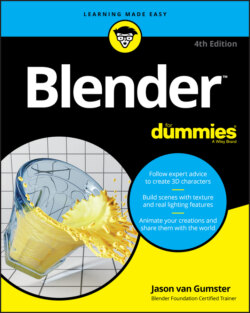Читать книгу Blender For Dummies - Jason van Gumster - Страница 38
Ways to see your 3D scene
ОглавлениеAside from changing the angle from which you view your 3D world, you may also want to change how the world is shown in the 3D Viewport. In particular, I’m referring to what is called the viewport shading. By default, Blender starts in the Solid shading type, which shows your models as solid 3D objects, lit by the studio lights you can set in Blender’s Preferences under Lights. You can change the viewport shading from the 3D Viewport’s header by clicking any of the Viewport Shading buttons, as shown in Figure 2-5.
There are four possible viewport shading types:
Wireframe: This viewport shading type shows the objects in your scene as transparent line-drawings. The wireframe viewport shading type is a good quick way to get an idea of the structure of your models. And because Wireframe is a bunch of lines, Blender doesn’t have to worry about shading and, therefore, doesn’t tax your computer’s processor as much. On older computers, Blender is a lot more responsive using Wireframe than any of the other viewport shading types.
Solid: Solid is the default viewport shading type that Blender starts with. Solid is usually the standard mode for working in Blender. It’s the shading type that allows you to focus on just the geometry of your model without being distracted by materials or scene lighting.
Look Dev: Short for “look development,” Look Dev is a process in computer graphics where you focus on creating the materials and shaders on your objects, their “look.” Sometimes this process is also called surfacing your objects. Blender’s Look Dev viewport shading type attempts to faithfully show you what your object looks like when textured and lit. Do note that the default behavior is not to use the lighting from your scene, but instead you have the option to light your scene using an assortment of different lighting scenarios, defined by high dynamic range images, or HDRIs.
Rendered: As you might expect, this viewport shading type renders your scene in the 3D Viewport from whatever arbitrary perspective you want. Depending on the complexity of your scene, this is a great way to get a very accurate preview of your final rendered images.Fair warning: the Rendered viewport shading type can be extremely slow when using the Cycles renderer. It’s much more responsive when using Eevee. See Chapter 16 for more on the differences between Cycles and Eevee.
You can also change viewport shading types by pressing Z to reveal a shading pie menu. The options here are the same as the shading types described in the previous paragraph. The only difference is that they’re faster to access by using the pie layout. Figure 2-5 has the pie menu of viewport shading types on the right side.
FIGURE 2-5: Viewport shading types from the 3D Viewport’s header (left) and from a pie menu (right).
You may also notice that if you have more than one 3D Viewport window, they don’t all have to have the same viewport shading type. You can see the wireframe of your model in one editor while adjusting the lighting using the Shaded draw type in another.
